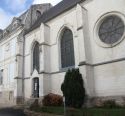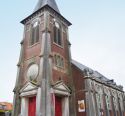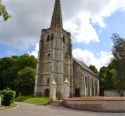Church | 1523-1761 | Classical, Neoclassical | Catholic Church

Map
Opening hours
01 June - 31 January
Mon
Tue 14.00 - 16.00
Wed
Thu 14.00 - 16.00
Fri
Sat
Sun
A series of renovation works is currently underway on the building, the roof of the tower and the steeple (restoration of the facade, carpentry, roofing and stained glass windows). During the various phases of the work - which began in April 2025 - the church will remain open (via a side entrance) on Tuesdays and Thursdays from 2pm to 4pm.
If you would like to help with the work, you can make a donation to the Association de sauvegarde pour l'église Saint-Martin de Pas-en-Artois* (asso.eglisepas@gmail.com).
*Your donation may be tax-deductible up to 66%.
Guided tour
Description
The seigneury of Pas-en-Artois reached its apogee in the 15th century, when there were at least four churches or chapels, testifying to the importance of the town before its decline as a result of the wars of the 16th and 17th centuries and its definitive incorporation into France. The only remaining church is Saint Martin, the oldest. Following the Christianisation of the village by the saint, its construction is linked to the early presence of a priory. It was also used by a collegiate church, which soon became associated with the priory and served jointly as the parish church.
After being damaged or demolished several times in wars, fires and floods, the current building was rebuilt in the second half of the 18th century. Of particular note is the bell tower with its original roof. The interesting interior decoration, with its painted ceiling and ten stained glass windows, dates from the second half of the 19th century.
The church has been listed as a Historic Monument since 2020, and the bell tower since 1929. Various objects, paintings and statues are also protected.
Translated with DeepL.com (free version)
Photos
Remarkable elements
The stained glass windows
Created by Arras master stained-glass artist Félix Courmont between 1868 and 1870, the windows are in a medieval style, reminiscent of 13th-century stained-glass windows.
Ten scenes are depicted: the Charity of Saint Martin, the Nazareth workshop, Saint Amédée, Saint Edmond, the four evangelists (Saints Luke, Matthew, Mark and John), the Annunciation and the rarer scene of the marriage of Mary and Joseph.
Translated with www.DeepL.com/Translator (free version)
The reliquary statue of Saint Benoît Labre
A traditional representation of the wandering saint from Amettes in the Pas-de-Calais.
Translated with www.DeepL.com/Translator (free version)
The painting of the Virgin and Child surrounded by angels and saints
This recently restored oil painting is a copy, donated by the State in 1872, of a 15th-century painting by Perugino, the original of which is in the Musée du Louvre. The Virgin and Child is enthroned at the centre of the composition, surrounded by two angels, Saint Rose of Viterbo holding a rose branch and Saint Catherine of Alexandria holding the Book of Wisdom and the Palm of Martyrdom.
Translated with www.DeepL.com/Translator (free version)
The side altars
The carved wooden side altars each feature a scene in high relief: on one side, the Virgin and Child, and on the other, the apparition of Christ to Martin on the night following the sharing of his cloak.
This dream strengthened his faith, leading him to leave the army and be baptised.
Translated with www.DeepL.com/Translator (free version)
The chandeliers
Two remarkable 19th-century chandeliers dominate the nave, one in crystal and the other in bronze.
Translated with www.DeepL.com/Translator (free version)
The bell tower
The first part of the building to be protected as a Historic Monument in 1929, the bell tower was rebuilt in 1773 using elements from its previous reconstruction in the 16th century, following a fire, as evidenced by the key above the door bearing the date 1532.
The original shape of this ‘bulbous’ bell-tower dominates the village and houses a single bell.
Translated with www.DeepL.com/Translator (free version)























